Md Ashraf Uddin
A Hierarchical IDS for Zero-Day Attack Detection in Internet of Medical Things Networks
Aug 14, 2025Abstract:The Internet of Medical Things (IoMT) is driving a healthcare revolution but remains vulnerable to cyberattacks such as denial of service, ransomware, data hijacking, and spoofing. These networks comprise resource constrained, heterogeneous devices (e.g., wearable sensors, smart pills, implantables), making traditional centralized Intrusion Detection Systems (IDSs) unsuitable due to response delays, privacy risks, and added vulnerabilities. Centralized IDSs require all sensors to transmit data to a central server, causing delays or network disruptions in dense environments. Running IDSs locally on IoMT devices is often infeasible due to limited computation, and even lightweight IDS components remain at risk if updated models are delayed leaving them exposed to zero-day attacks that threaten patient health and data security. We propose a multi level IoMT IDS framework capable of detecting zero day attacks and distinguishing between known and unknown threats. The first layer (near Edge) filters traffic at a coarse level (attack or not) using meta-learning or One Class Classification (OCC) with the usfAD algorithm. Subsequent layers (far Edge, Cloud) identify attack type and novelty. Experiments on the CICIoMT2024 dataset show 99.77 percentage accuracy and 97.8 percentage F1-score. The first layer detects zero-day attacks with high accuracy without needing new datasets, ensuring strong applicability in IoMT environments. Additionally, the meta-learning approach achieves high.
A Scalable Hierarchical Intrusion Detection System for Internet of Vehicles
May 22, 2025Abstract:Due to its nature of dynamic, mobility, and wireless data transfer, the Internet of Vehicles (IoV) is prone to various cyber threats, ranging from spoofing and Distributed Denial of Services (DDoS) attacks to malware. To safeguard the IoV ecosystem from intrusions, malicious activities, policy violations, intrusion detection systems (IDS) play a critical role by continuously monitoring and analyzing network traffic to identify and mitigate potential threats in real-time. However, most existing research has focused on developing centralized, machine learning-based IDS systems for IoV without accounting for its inherently distributed nature. Due to intensive computing requirements, these centralized systems often rely on the cloud to detect cyber threats, increasing delay of system response. On the other hand, edge nodes typically lack the necessary resources to train and deploy complex machine learning algorithms. To address this issue, this paper proposes an effective hierarchical classification framework tailored for IoV networks. Hierarchical classification allows classifiers to be trained and tested at different levels, enabling edge nodes to detect specific types of attacks independently. With this approach, edge nodes can conduct targeted attack detection while leveraging cloud nodes for comprehensive threat analysis and support. Given the resource constraints of edge nodes, we have employed the Boruta feature selection method to reduce data dimensionality, optimizing processing efficiency. To evaluate our proposed framework, we utilize the latest IoV security dataset CIC-IoV2024, achieving promising results that demonstrate the feasibility and effectiveness of our models in securing IoV networks.
Hybridized Convolutional Neural Networks and Long Short-Term Memory for Improved Alzheimer's Disease Diagnosis from MRI Scans
Mar 08, 2024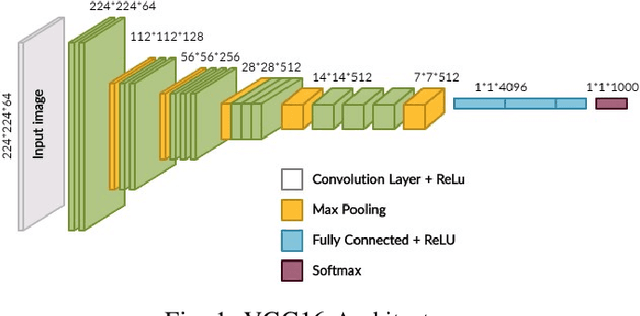
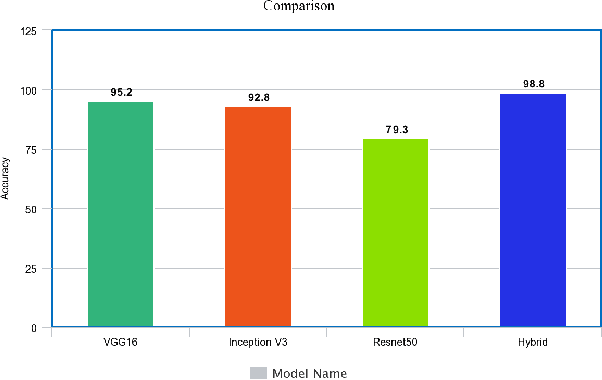
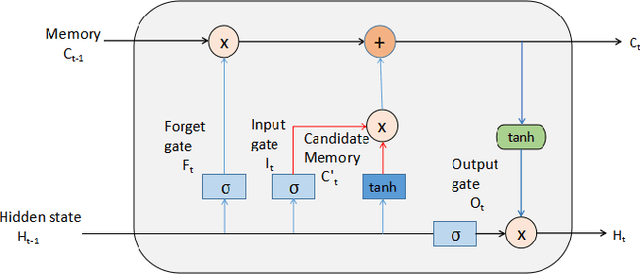
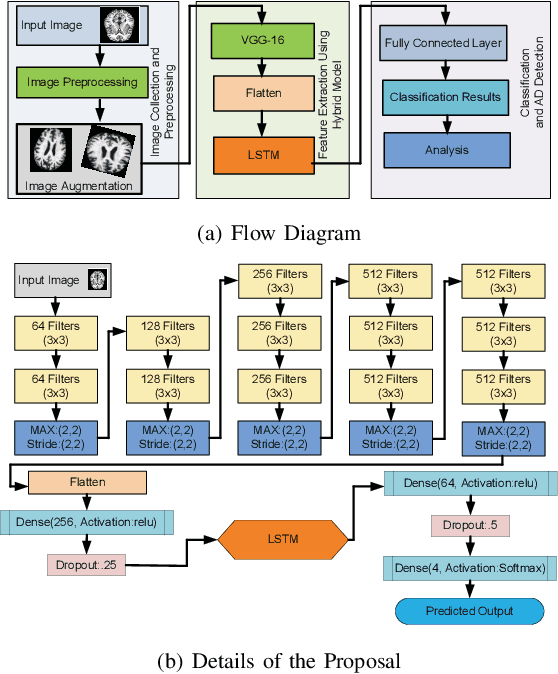
Abstract:Brain-related diseases are more sensitive than other diseases due to several factors, including the complexity of surgical procedures, high costs, and other challenges. Alzheimer's disease is a common brain disorder that causes memory loss and the shrinking of brain cells. Early detection is critical for providing proper treatment to patients. However, identifying Alzheimer's at an early stage using manual scanning of CT or MRI scans is challenging. Therefore, researchers have delved into the exploration of computer-aided systems, employing Machine Learning and Deep Learning methodologies, which entail the training of datasets to detect Alzheimer's disease. This study aims to present a hybrid model that combines a CNN model's feature extraction capabilities with an LSTM model's detection capabilities. This study has applied the transfer learning called VGG16 in the hybrid model to extract features from MRI images. The LSTM detects features between the convolution layer and the fully connected layer. The output layer of the fully connected layer uses the softmax function. The training of the hybrid model involved utilizing the ADNI dataset. The trial findings revealed that the model achieved a level of accuracy of 98.8%, a sensitivity rate of 100%, and a specificity rate of 76%. The proposed hybrid model outperforms its contemporary CNN counterparts, showcasing a superior performance.
Exploring Gene Regulatory Interaction Networks and predicting therapeutic molecules for Hypopharyngeal Cancer and EGFR-mutated lung adenocarcinoma
Feb 27, 2024Abstract:With the advent of Information technology, the Bioinformatics research field is becoming increasingly attractive to researchers and academicians. The recent development of various Bioinformatics toolkits has facilitated the rapid processing and analysis of vast quantities of biological data for human perception. Most studies focus on locating two connected diseases and making some observations to construct diverse gene regulatory interaction networks, a forerunner to general drug design for curing illness. For instance, Hypopharyngeal cancer is a disease that is associated with EGFR-mutated lung adenocarcinoma. In this study, we select EGFR-mutated lung adenocarcinoma and Hypopharyngeal cancer by finding the Lung metastases in hypopharyngeal cancer. To conduct this study, we collect Mircorarray datasets from GEO (Gene Expression Omnibus), an online database controlled by NCBI. Differentially expressed genes, common genes, and hub genes between the selected two diseases are detected for the succeeding move. Our research findings have suggested common therapeutic molecules for the selected diseases based on 10 hub genes with the highest interactions according to the degree topology method and the maximum clique centrality (MCC). Our suggested therapeutic molecules will be fruitful for patients with those two diseases simultaneously.
Securing Transactions: A Hybrid Dependable Ensemble Machine Learning Model using IHT-LR and Grid Search
Feb 22, 2024



Abstract:Financial institutions and businesses face an ongoing challenge from fraudulent transactions, prompting the need for effective detection methods. Detecting credit card fraud is crucial for identifying and preventing unauthorized transactions.Timely detection of fraud enables investigators to take swift actions to mitigate further losses. However, the investigation process is often time-consuming, limiting the number of alerts that can be thoroughly examined each day. Therefore, the primary objective of a fraud detection model is to provide accurate alerts while minimizing false alarms and missed fraud cases. In this paper, we introduce a state-of-the-art hybrid ensemble (ENS) dependable Machine learning (ML) model that intelligently combines multiple algorithms with proper weighted optimization using Grid search, including Decision Tree (DT), Random Forest (RF), K-Nearest Neighbor (KNN), and Multilayer Perceptron (MLP), to enhance fraud identification. To address the data imbalance issue, we employ the Instant Hardness Threshold (IHT) technique in conjunction with Logistic Regression (LR), surpassing conventional approaches. Our experiments are conducted on a publicly available credit card dataset comprising 284,807 transactions. The proposed model achieves impressive accuracy rates of 99.66%, 99.73%, 98.56%, and 99.79%, and a perfect 100% for the DT, RF, KNN, MLP and ENS models, respectively. The hybrid ensemble model outperforms existing works, establishing a new benchmark for detecting fraudulent transactions in high-frequency scenarios. The results highlight the effectiveness and reliability of our approach, demonstrating superior performance metrics and showcasing its exceptional potential for real-world fraud detection applications.
MLSTL-WSN: Machine Learning-based Intrusion Detection using SMOTETomek in WSNs
Feb 22, 2024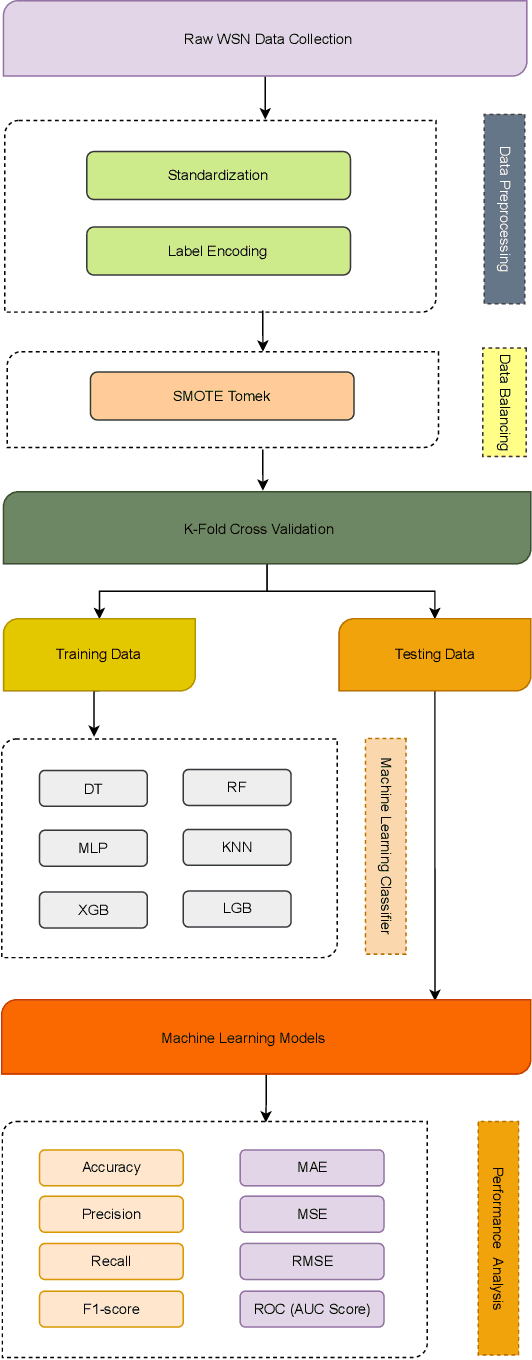

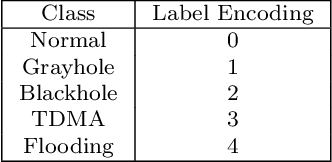
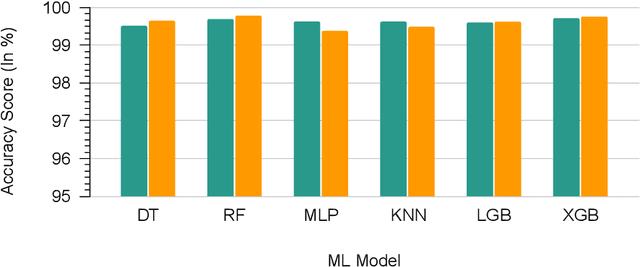
Abstract:Wireless Sensor Networks (WSNs) play a pivotal role as infrastructures, encompassing both stationary and mobile sensors. These sensors self-organize and establish multi-hop connections for communication, collectively sensing, gathering, processing, and transmitting data about their surroundings. Despite their significance, WSNs face rapid and detrimental attacks that can disrupt functionality. Existing intrusion detection methods for WSNs encounter challenges such as low detection rates, computational overhead, and false alarms. These issues stem from sensor node resource constraints, data redundancy, and high correlation within the network. To address these challenges, we propose an innovative intrusion detection approach that integrates Machine Learning (ML) techniques with the Synthetic Minority Oversampling Technique Tomek Link (SMOTE-TomekLink) algorithm. This blend synthesizes minority instances and eliminates Tomek links, resulting in a balanced dataset that significantly enhances detection accuracy in WSNs. Additionally, we incorporate feature scaling through standardization to render input features consistent and scalable, facilitating more precise training and detection. To counteract imbalanced WSN datasets, we employ the SMOTE-Tomek resampling technique, mitigating overfitting and underfitting issues. Our comprehensive evaluation, using the WSN Dataset (WSN-DS) containing 374,661 records, identifies the optimal model for intrusion detection in WSNs. The standout outcome of our research is the remarkable performance of our model. In binary, it achieves an accuracy rate of 99.78% and in multiclass, it attains an exceptional accuracy rate of 99.92%. These findings underscore the efficiency and superiority of our proposal in the context of WSN intrusion detection, showcasing its effectiveness in detecting and mitigating intrusions in WSNs.
Machine learning-based network intrusion detection for big and imbalanced data using oversampling, stacking feature embedding and feature extraction
Jan 22, 2024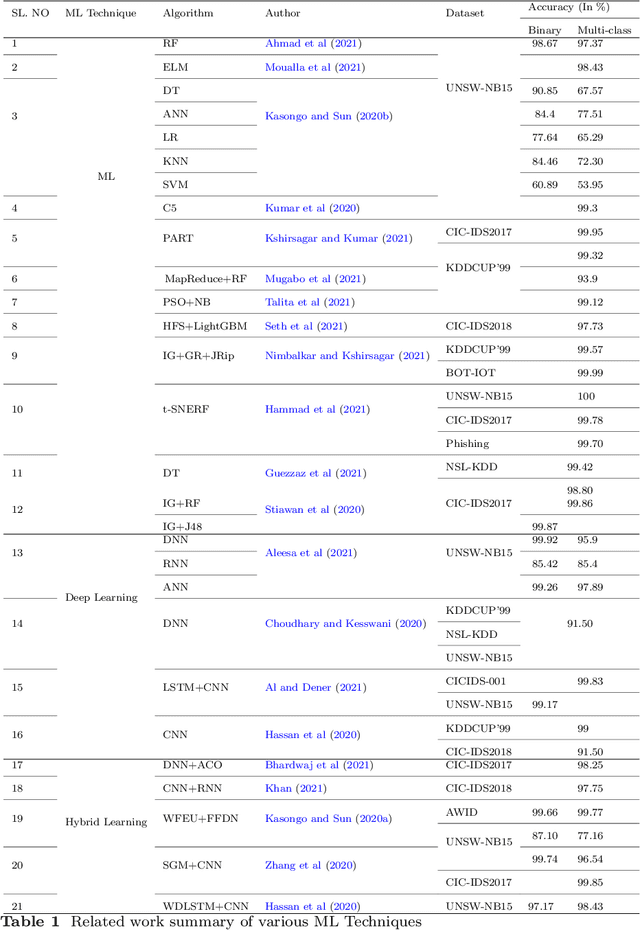
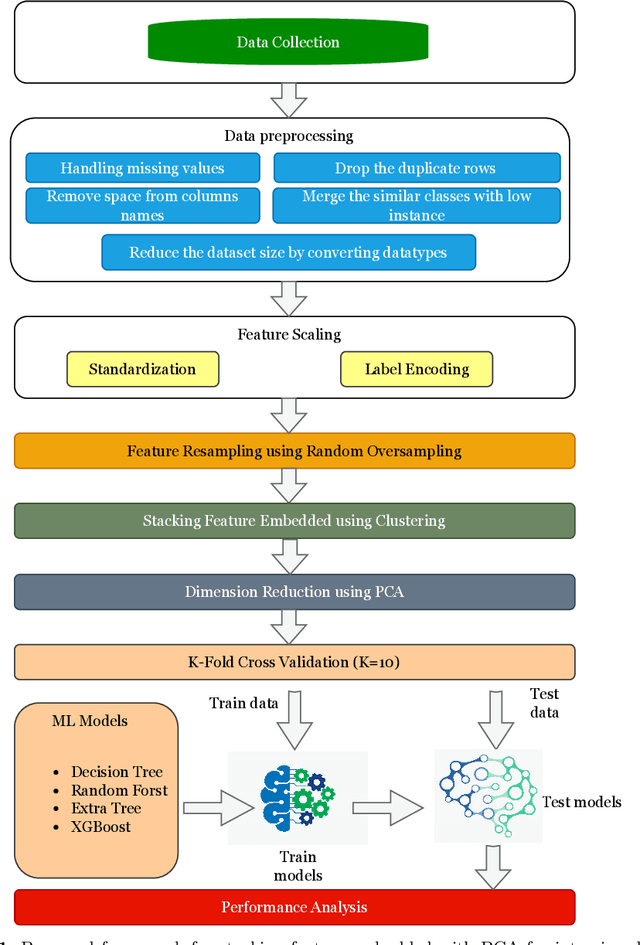
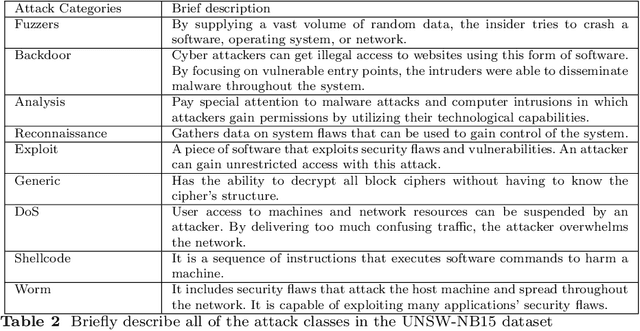
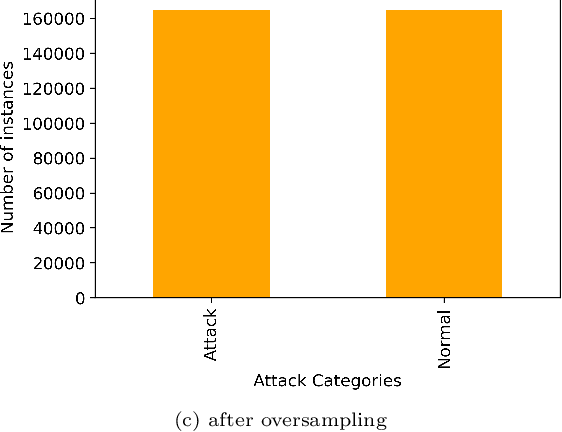
Abstract:Cybersecurity has emerged as a critical global concern. Intrusion Detection Systems (IDS) play a critical role in protecting interconnected networks by detecting malicious actors and activities. Machine Learning (ML)-based behavior analysis within the IDS has considerable potential for detecting dynamic cyber threats, identifying abnormalities, and identifying malicious conduct within the network. However, as the number of data grows, dimension reduction becomes an increasingly difficult task when training ML models. Addressing this, our paper introduces a novel ML-based network intrusion detection model that uses Random Oversampling (RO) to address data imbalance and Stacking Feature Embedding based on clustering results, as well as Principal Component Analysis (PCA) for dimension reduction and is specifically designed for large and imbalanced datasets. This model's performance is carefully evaluated using three cutting-edge benchmark datasets: UNSW-NB15, CIC-IDS-2017, and CIC-IDS-2018. On the UNSW-NB15 dataset, our trials show that the RF and ET models achieve accuracy rates of 99.59% and 99.95%, respectively. Furthermore, using the CIC-IDS2017 dataset, DT, RF, and ET models reach 99.99% accuracy, while DT and RF models obtain 99.94% accuracy on CIC-IDS2018. These performance results continuously outperform the state-of-art, indicating significant progress in the field of network intrusion detection. This achievement demonstrates the efficacy of the suggested methodology, which can be used practically to accurately monitor and identify network traffic intrusions, thereby blocking possible threats.
Empowering COVID-19 Detection: Optimizing Performance Through Fine-Tuned EfficientNet Deep Learning Architecture
Nov 28, 2023Abstract:The worldwide COVID-19 pandemic has profoundly influenced the health and everyday experiences of individuals across the planet. It is a highly contagious respiratory disease requiring early and accurate detection to curb its rapid transmission. Initial testing methods primarily revolved around identifying the genetic composition of the coronavirus, exhibiting a relatively low detection rate and requiring a time-intensive procedure. To address this challenge, experts have suggested using radiological imagery, particularly chest X-rays, as a valuable approach within the diagnostic protocol. This study investigates the potential of leveraging radiographic imaging (X-rays) with deep learning algorithms to swiftly and precisely identify COVID-19 patients. The proposed approach elevates the detection accuracy by fine-tuning with appropriate layers on various established transfer learning models. The experimentation was conducted on a COVID-19 X-ray dataset containing 2000 images. The accuracy rates achieved were impressive of 100% for EfficientNetB4 model. The fine-tuned EfficientNetB4 achieved an excellent accuracy score, showcasing its potential as a robust COVID-19 detection model. Furthermore, EfficientNetB4 excelled in identifying Lung disease using Chest X-ray dataset containing 4,350 Images, achieving remarkable performance with an accuracy of 99.17%, precision of 99.13%, recall of 99.16%, and f1-score of 99.14%. These results highlight the promise of fine-tuned transfer learning for efficient lung detection through medical imaging, especially with X-ray images. This research offers radiologists an effective means of aiding rapid and precise COVID-19 diagnosis and contributes valuable assistance for healthcare professionals in accurately identifying affected patients.
* Computers in Biology and Medicine [Q1, IF: 7.7, CS: 9.2]
An efficient deep learning model to categorize brain tumor using reconstruction and fine-tuning
May 22, 2023Abstract:Brain tumors are among the most fatal and devastating diseases, often resulting in significantly reduced life expectancy. An accurate diagnosis of brain tumors is crucial to devise treatment plans that can extend the lives of affected individuals. Manually identifying and analyzing large volumes of MRI data is both challenging and time-consuming. Consequently, there is a pressing need for a reliable deep learning (DL) model to accurately diagnose brain tumors. In this study, we propose a novel DL approach based on transfer learning to effectively classify brain tumors. Our novel method incorporates extensive pre-processing, transfer learning architecture reconstruction, and fine-tuning. We employ several transfer learning algorithms, including Xception, ResNet50V2, InceptionResNetV2, and DenseNet201. Our experiments used the Figshare MRI brain tumor dataset, comprising 3,064 images, and achieved accuracy scores of 99.40%, 99.68%, 99.36%, and 98.72% for Xception, ResNet50V2, InceptionResNetV2, and DenseNet201, respectively. Our findings reveal that ResNet50V2 achieves the highest accuracy rate of 99.68% on the Figshare MRI brain tumor dataset, outperforming existing models. Therefore, our proposed model's ability to accurately classify brain tumors in a short timeframe can aid neurologists and clinicians in making prompt and precise diagnostic decisions for brain tumor patients.
A Dependable Hybrid Machine Learning Model for Network Intrusion Detection
Dec 08, 2022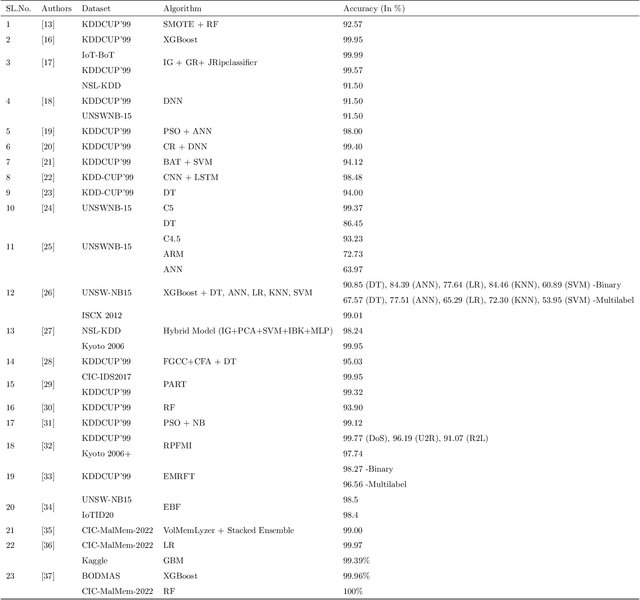
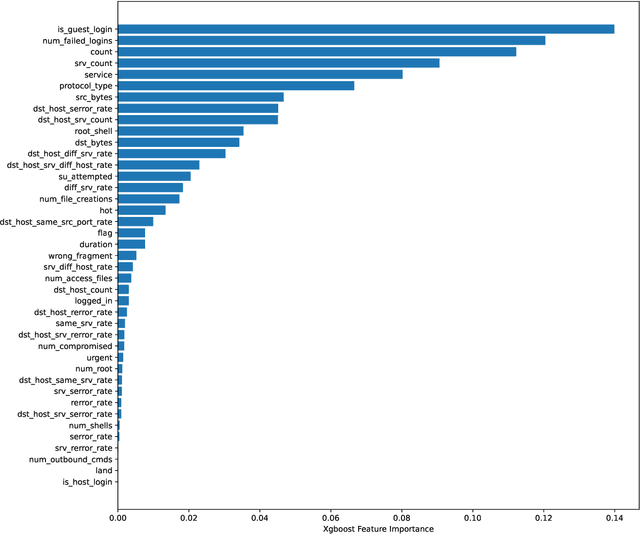
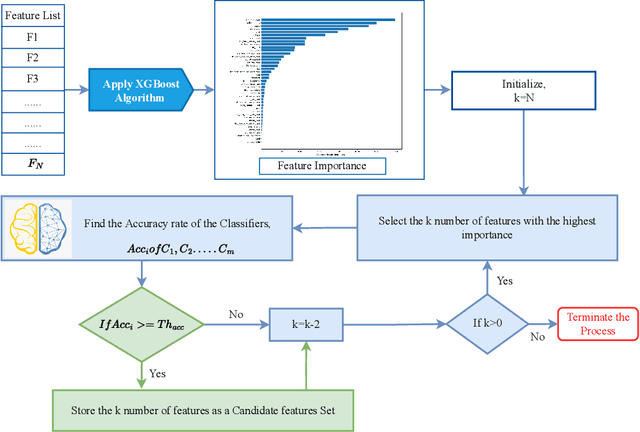
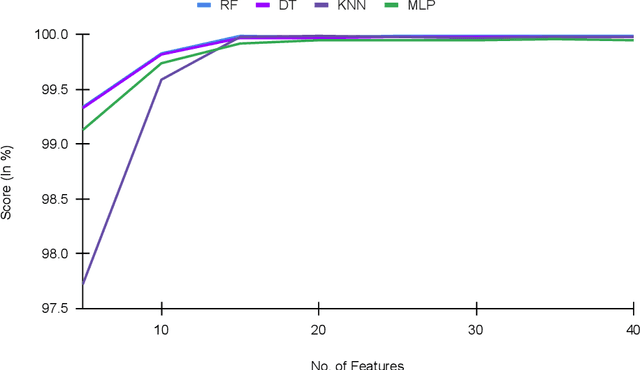
Abstract:Network intrusion detection systems (NIDSs) play an important role in computer network security. There are several detection mechanisms where anomaly-based automated detection outperforms others significantly. Amid the sophistication and growing number of attacks, dealing with large amounts of data is a recognized issue in the development of anomaly-based NIDS. However, do current models meet the needs of today's networks in terms of required accuracy and dependability? In this research, we propose a new hybrid model that combines machine learning and deep learning to increase detection rates while securing dependability. Our proposed method ensures efficient pre-processing by combining SMOTE for data balancing and XGBoost for feature selection. We compared our developed method to various machine learning and deep learning algorithms to find a more efficient algorithm to implement in the pipeline. Furthermore, we chose the most effective model for network intrusion based on a set of benchmarked performance analysis criteria. Our method produces excellent results when tested on two datasets, KDDCUP'99 and CIC-MalMem-2022, with an accuracy of 99.99% and 100% for KDDCUP'99 and CIC-MalMem-2022, respectively, and no overfitting or Type-1 and Type-2 issues.
 Add to Chrome
Add to Chrome Add to Firefox
Add to Firefox Add to Edge
Add to Edge